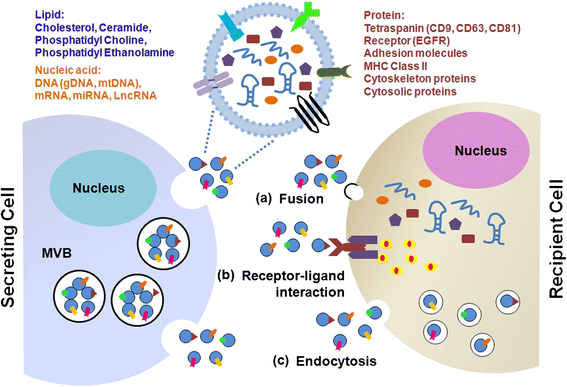Exosomes in cancer: small particle, big player
- PMID: 26156517
- PMCID: PMC4496882
- DOI: 10.1186/s13045-015-0181-x
Exosomes in cancer: small particle, big player
Abstract
Exosomes have emerged as a novel mode of intercellular communication. Exosomes can shuttle bioactive molecules including proteins, DNA, mRNA, as well as non-coding RNAs from one cell to another, leading to the exchange of genetic information and reprogramming of the recipient cells. Increasing evidence suggests that tumor cells release excessive amount of exosomes, which may influence tumor initiation, growth, progression, metastasis, and drug resistance. In addition, exosomes transfer message from tumor cells to immune cells and stromal cells, contributing to the escape from immune surveillance and the formation of tumor niche. In this review, we highlight the recent advances in the biology of exosomes as cancer communicasomes. We review the multifaceted roles of exosomes, the small secreted particles, in communicating with other cells within tumor microenvironment. Given that exosomes are cell type specific, stable, and accessible from body fluids, exosomes may provide promising biomarkers for cancer diagnosis and represent new targets for cancer therapy.
Figures


References
-
- Thery C, Zitvogel L, Amigorena S. Exosomes: composition, biogenesis and function. Nat Rev Immunol. 2002;2(8):569–579. - PubMed
-
- Trajkovic K, Hsu C, Chiantia S, Rajendran L, Wenzel D, Wieland F, et al. Ceramide triggers budding of exosome vesicles into multivesicular endosomes. Science. 2008;319(5867):1244–1247. - PubMed
-
- Baietti MF, Zhang Z, Mortier E, Melchior A, Degeest G, Geeraerts A, et al. Syndecan-syntenin-ALIX regulates the biogenesis of exosomes. Nat Cell Biol. 2012;14(7):677–685. - PubMed
-
- Ostrowski M, Carmo NB, Krumeich S, Fanget I, Raposo G, Savina A, et al. Rab27a and Rab27b control different steps of the exosome secretion pathway. Nat Cell Biol. 2010;12(1):1–13. - PubMed
Publication types
MeSH terms
Substances
LinkOut - more resources
Full Text Sources
Other Literature Sources

